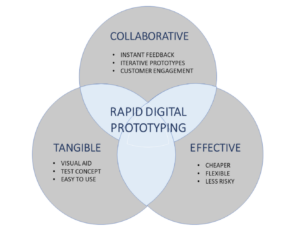Rapid Digital Prototyping: Evaluating a Go-to-Market Strategy More Leanly
Rapid prototyping is used across a variety of industries and fields to quickly create designs so functionality and business requirements can effortlessly be brought to life and more concretely assessed. Instead of long, strategic assessments that seek to understand a market, why not rapidly develop digital prototypes as a way to get internal and external alignment in environments that more closely resemble real-world applications?
Adding digital prototyping into an organization’s toolkit is not complicated and can bring effective ways to collaborate in an increasingly more digital world. In our experience, we have seen both life sciences and CPG organizations benefit from rapid prototyping. While there are likely countless areas where digital prototyping can be applied, over the past several years we have seen several practical use cases where digital prototyping principles come to shine.
Digital Prototyping Principles
- Quickly testing the feasibility of a new market. Instead of using a waterfall approach to test the feasibility of a new market entry, what if you could launch quickly, learn, and either sunset or scale the launch? For example, we’ve worked with clients to launch an eCommerce platform, driving paid traffic to a website to see whether potential new buyers are interested in a prototyped product and actually convert. This has many side benefits: assessing the market, the ability to constantly refine and hone in on the value proposition for the new product and messaging, and setting up an organization to realize the challenges and opportunities that lie ahead to scale the original idea. Clear OKRs (objectives and key results) can be set from the onset to evaluate go/no-go decisions, and it allows organizations to give new and important assignments to emerging talent that might otherwise leave the company in search for more thrilling or faster-paced organizations.
- Bringing requirements to life with a ‘Clickable’ prototype. As much as anyone loves an Excel with 100s of lines of requirements and user stories, these files are hard for senior management (and most people that lack the right context) to absorb and to understand nuanced ideas – there is a reason why a picture is worth a thousand words. Quickly visualizing requirements into a clickable digital prototype leapfrogs the experience: business owners can see and experience workflows and quickly define additional functionality that can be immediately tested with end users. Additionally, gathering new features (some which may not have been thought of in a traditional user-story gathering process) becomes easier. From there, a more traditional agile approach can take over to execution.
- Evaluating options and “the art of the possible.” Digital rapid prototyping can quickly generate tangible options and scenarios for the business – as well as end users, consumers, patients, and/or HCPs – to react to. Once again, organizations no longer have to develop an idea to get feedback, iterate, and improve on the idea before it even gets to market.
As we look at the above use cases – and as mentioned, potentially dozens more – additional benefits can be grouped into three major areas:
Benefits of Rapid Digital Prototyping

Promotes collaborative cross-functional iterations
The creation of prototypes is just as important as receiving feedback from customers. By using rapid prototyping, businesses can easily and instantaneously create iterative tangible ideas in the early stages of development. The creation of multiple tests in an initial project phase allows businesses to test prototypes with customers and create an ideal customer experience. Therefore, receiving instant feedback and making the changes immediately creates a collaborative environment for development – both from internal and external stakeholders. Taking this a step further, some organizations (especially in the B2B space) can use the opportunity to build something from the ground up as a way of collaborating and partnering with customers – to make them a part of the ultimate solution.
Creates a tangible product quickly
It is estimated that upwards of 65% of people are visual learners. Creating a visual aid to illustrate concepts helps organizations and its customers better understand and pressure-test an idea – especially when requirements are complex and/or intertwined (as is always the case). While traditional approaches might take months or even years (given the end-to-end process is cumbersome and sometimes riddled with bureaucracy), Clarkston has developed digital prototypes within a few days to walk through concepts and test business and customer interactions within weeks. This quick turnaround allows businesses to develop and confirm key attributes in an effective manner and move away from “assessments” and closer to real-life, tangible assets.
Relatively inexpensive, better, & less risky
Resources, speed, and risk play critical roles in businesses to constantly innovate and thrive. In previous projects, we have created low-fidelity digital prototypes within a few days and tools that are readily available and relatively inexpensive compared to the alternatives – the magic comes to life in the operator and the approach to rapid prototyping, not in the tool itself. For example, working with a life sciences client, we developed digital prototypes during initial phases and departments were kept informed about the progress, allowing us to reduce the risk and hesitancy surrounding the design and the idea itself. Also, by spending money early in the project, businesses can decide to move forward or nix projects more quickly before additional money or time is spent. This process sets the table to expedite projects and aid with reducing time to market.
Now What?
Overall, the ability for organizations to use digital prototypes as nascent and every-day tools may seem far-fetched… but so was potentially the world before Microsoft Word and Excel became a larger norm across companies in the late 1980s and onwards.
Digital prototyping provides a framework and a way for organizations to think about decision making and their go-to-market strategies. Digital prototyping provides agility so businesses can swiftly adapt to an ever-changing market reality: we live in a “swipe world” and organizational leaders need to arm their people with the right skills to service consumers in the 21st century.



